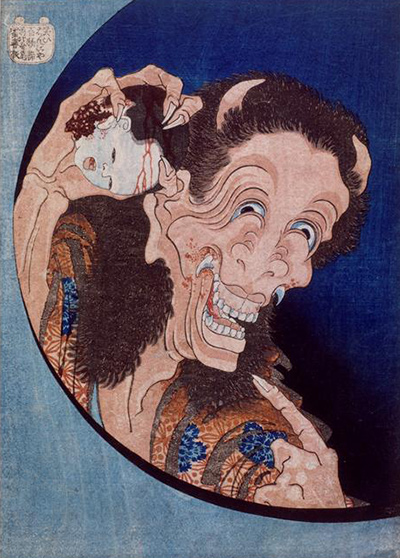Hokusai
Laughing Demon by Hokusai
The Laughing Demon is a woodcut painting created by Hokusai in 1830. The painting depicts a demon with the face of two of Japans most well known mythological demons the Yamauba and Hannya. This painting is one of Hokusai’s later paintings and was painted 18 years before his death. It was painted around the same time as his most legendary collection “thirty-six views of Mount Fuji.”
The demons depicted in this painting have a long and prestigious history. The Yamauba is traditionally depicted as a crone who has unkempt hair and wearing either filthy clothes or clothes made of tree bark. In general, this demon is said to eat infants who are brought to her mountain home. Aside from this tale, there are also stories of how the Yamauba attacks merchants and horse drivers walking along the mountain path. Interestingly enough in the tale “Ubakawa” a yamaba actually gives a human good luck and in one prefecture houses possessed by a Yamauba would gain great wealth and fortune.
The Hannya is a traditional Japanese demon that is said to be a woman who turns into a demon due to intense jealousy. The most famous portrayal of the Hannya is the Hannya mask used in traditional Noh theatre. This mask is seen as showing the two sides of humanity. With the mask appearing horrifying and angry from the front but from the side the mask appears melancholy. There are traditionally three kinds of Hannya mask.
The first is a white mask that appears slightly more composed than the others. The second is the Red Hannya this mask has the hair of the demon in disarray and is meant to show the demons progression into madness and finally, there is the Black hannya that is meant to represent the woman’s complete descent into demon-hood. In conclusion, this painting is a beautiful example of Hokusai’s style. It is a beautiful example of traditional Japanese woodcuts.
